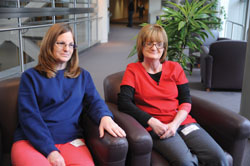
From left, Paula Allen and Louise Benge, both from Brodhead, Ky., are sisters who participate in the NIH Undiagnosed Diseases Program. Their cases led to discovery of a rare disorder that causes calcification of their arteries in hips, legs, and feet.
Photo: Jeannine Mjoseth, NHGRI
Kentucky sisters now have clues to lifelong, painful disorder
As a child, Paula Allen, 51, of Brodhead, Ky., loved to play “Kick the Can,” “Ghost in the Graveyard,” and other running games with her playmates. But then pain entered her life. By the time she was 18, pain in her hands drove her to the doctor—she thought arthritis—but the tests came back negative. By her 30s, the pain in her legs was so bad it prevented her from getting a good night’s sleep. Local doctors didn’t know the cause but suggested arterial surgery could help, although she would need to repeat it every five years. Paula declined.
The pain continued.
Her older sister, Louise Benge, 56, also of Brodhead, was in her 20s when she first experienced similar, unexplained leg pain. Again, doctors could not identify the disorder but blamed blockage of blood vessels for her discomfort.
And the pain continued.
Finally, in 2009, Louise’s physician, Karen Saylor, M.D., of Mount Vernon, Ky., referred Louise and Paula to NIH’s Undiagnosed Diseases Program (UDP), a unique three-year-old NIH multidisciplinary initiative that seeks to provide answers to patients with mysterious conditions that have long eluded diagnosis, and advance medical knowledge about rare and common diseases.
Accepted into the UDP that May, the sisters, their three siblings, and their parents (who do not have the disease) visited the NIH Clinical Center for a week of intensive clinical and laboratory testing, evaluation, and consultation. It was worth it.
Clinical investigators from the National Human Genome Research Institute (NHGRI) and the National Heart, Lung, and Blood Institute (NHLBI) found that the pain Paula, Louise, and their siblings continue to suffer is due to ACDC, a rare genetic disorder that permits calcium to build up in arteries below the waist and in the hands, blocking blood flow and making walking and other movements painfully difficult. Fortunately, ACDC spares the arteries of the heart.

Louise Benge is monitored while walking, as part of testing for a rare genetic disorder, ACDC, at the Clinical Center on the NIH campus in Bethesda, Md. Annette Stine, research coordinator at the National Heart, Lung, and Blood Institute, monitors the treadmill test.
Photo: Jeannine Mjoseth, NHGRI
ACDC is an inherited recessive disorder, meaning that Paula, Louise, and their siblings inherited two copies of the mutation, one from each parent, thus causing their debilitation.
While she continues to take medication to thin her blood and ibuprofen for pain, Paula now has hope a treatment may someday be found. “I am excited they found a cause and hope they can learn something that might help us or someone else,” she says.
Back in Kentucky, Louise, too, remains hopeful. “It has impressed me that they want to help us at NIH,” she says. “At a lot of places, they have said we should just go about our business.”
How to Participate in the Program
If you are interested in participating in the NIH Undiagnosed Diseases Program, discuss the option with your primary physician or healthcare provider (nurse practitioner or physician assistant). Information specialists at the Clinical Center's Patient Recruitment Call Center (1-866-444-8806) can provide more information about eligibility and what kinds of medical information referring physicians must submit for review. You or your healthcare provider may call.
Patients must be referred by a physician or other healthcare provider. Information that must go directly to NIH includes:
- A summary letter describing your condition, when it was first noted, and your current health status.
- A list of treatments and medications that have already been tried and their effects.
- Copies of reports and results of pertinent diagnostic tests, along with X-rays, MRI results, and other imaging records/studies. Copies of actual studies are preferred.
Request and keep copies of all materials. Because of confidentiality considerations, no e-mail submissions are accepted. Your referring physician must mail the summary and materials to:
National Human Genome Research Institute
National Institutes of Health Undiagnosed
Diseases Program
10 Center Drive - MSC 1851, Building 10,
Room 10C103
Bethesda, MD 20892-1851
Call for More Information
Information specialists at the Clinical Center’s Patient Recruitment Call Center can provide more information.
Please call 1-866-444-8806.
